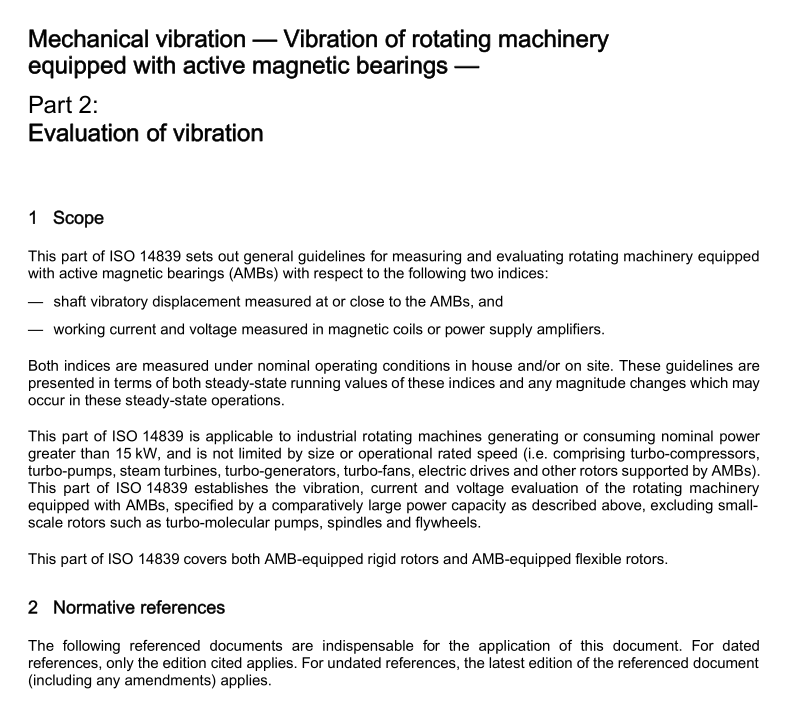BS ISO 14839-2 pdf download

BS ISO 14839-2 pdf download Mechanical vibration — Vibration of rotating machinery equipped with active magnetic bearings — Part 2: Evaluation of vibration
1 Scope
This part of lSO 14839 sets out general guidelines for measuring and evaluating rotating machinery equippedwith active magnetic bearings (AMBs) with respect to the following two indices:
— shaft vibratory displacement measured at or close to the AMBs, and
– working current and voltage measured in magnetic coils or power supply amplifiers.
Both indices are measured under nominal operating conditions in house and/or on site. These guidelines arepresented in terms of both steady-state running values of these indices and any magnitude changes which mayoccur in these steady-state operations.
This part of lSO 14839 is applicable to industrial rotating machines generating or consuming nominal powergreater than 15 kW, and is not limited by size or operational rated speed (i.e. comprising turbo-compressors,turbo-pumps, steam turbines, turbo-generators, turbo-fans, electric drives and other rotors supported by AMBs).This part of ISO 14839 establishes the vibration, current and voltage evaluation of the rotating machineryequipped with AMBs, specified by a comparatively large power capacity as described above,excluding small-scale rotors such as turbo-molecular pumps, spindles and flywheels.
This part of lSO 14839 covers both AMB-equipped rigid rotors and AMB-equipped flexible rotors.
2Normative references
The following referenced documents are indispensable for the application of this document. For datedreferences, only the edition cited applies. For undated references, the latest edition of the referenced document(including any amendments) applies.
ISo 7919-1,Mechanical vibration of non-reciprocating machines —- Measurements on rotating shafts andevaluation criteria- Part 1: General guidelines
3Measurement and evaluation procedures
3.1 Description of rotor-AMB system
A typical rotor system supported by AMBs is illustrated in Figure 1.An AMB is located at each end of the shaftand includes an adjacent displacement transducer and an emergency (auxiliary) ball bearing.The axial AMB isomitted in this figure. The control network for driving the AMB device is shown in Figure 2.As shown in thesefigures, each displacement transducer detects the shaft journal position at the bearing locations and its signal isfed back to the controller. Deviation from the bearing centre is delivered to the controller. This controller might,for example, implement a proportional, integral and differential actions (PID) control algorithm.The controllerdrives the power amplifiers to supply the coil current. If the shaft moves downward, the upper electromagneticcoil is activated to lift the rotor upward by the magnetic force. Since, in this manner, the magnetic force acts
3.2 Displacement
Throughout this part of ISO 14839, the term “vibratory displacement” refers to the total displacement of the shaft from the bearing’s centre, including any static displacement. The vibration measurement of the stationary parts of the machine (e.g. bearing housing) is excluded from this part of ISO 14839. AMB equipment in rotating machines has its own displacement transducers for detecting shaft movement, x(t) and y(t) , as shown in Figure 3. No additional displacement transducers are required. The detected values of shaft vibratory position by these displacement transducers is the subject of this part of ISO 14839.
As shown in Figure 3, the displacement transducers are oriented in the x and y directions at each radial bearing. The signals from these displacement transducers indicate the rotor journal position including the d.c. component (eccentricity) and a.c. component (vibration orbit) as shown in Figure 4. Eccentricities from the clearance centre of the AMB (designated O–O j ) in the x and y directions are designated ε x , ε y , while the vibration orbit amplitudes in the x and y directions are designated a x , a y . The maximum displacement of the rotor from the clearance centre of the radial AMB, designated D max , can be calculated from Equation (1) exactly D max = max x 2 ( t ) + y 2 ( t









